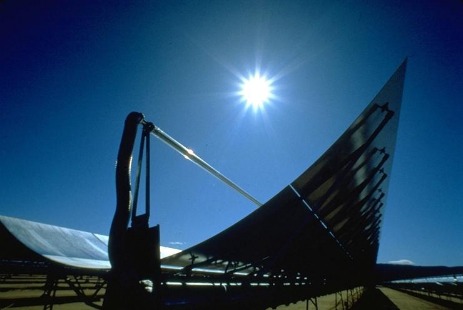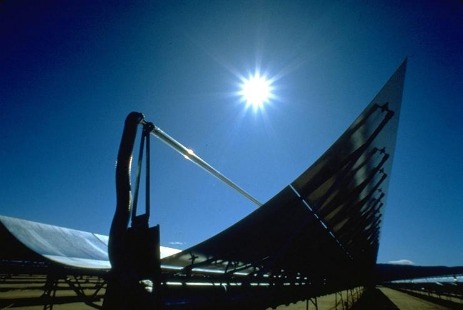 Are prospects dimming for solar thermal?Photo: WikipediaAre those big solar thermal power plants now under construction in California destined to become technological white elephants?
Are prospects dimming for solar thermal?Photo: WikipediaAre those big solar thermal power plants now under construction in California destined to become technological white elephants?
That’s the tentative conclusion of a new report from GTM Research, which predicts declining costs for photovoltaic panels may crush the competitiveness of solar thermal, also known as concentrating solar power, or CSP.
“Paradoxically, CSP is simultaneously experiencing unprecedented growth and facing extinction,” Brett Prior, a GTM Research senior analyst and the report’s author, said in a statement
Photovoltaic panels, like those found on residential rooftops, produce electricity by converting photons that strike semiconducting materials into electrons. Solar thermal power plants, on the other hand, generate electricity by using huge arrays of mirrors to focus the sun on a liquid to create steam that drives a turbine.
Solar thermal plants are more efficient at generating electricity and thus can produce power more cheaply than solar panels. Over the past several months, California regulators have licensed nine large-scale solar thermal power plants that would generate 4,100 megawatts. Those projects, to be built in the California desert, are considered crucial for the state’s three big investor-owned utilities to meet a mandate to obtain a third of their electricity from renewable sources.
But over the past two years photovoltaic — PV — module prices have fallen 50 percent, as low-cost Chinese manufacturers ramp up production and the United States’ First Solar continued to cut the costs of its thin-film solar cells.
“Certain projects announced in 2007 to 2009, with signed utility contracts in hand, are finally securing financing, breaking ground and will eventually become the largest solar plants the world has ever seen,” said Prior. “However, the future of the industry is at risk due to the dramatic decline in PV panel costs, which is compelling utilities to select lower-cost PV over CSP for future solar plants, thereby pushing the CSP industry toward potential obsolescence.”
Indeed, last month utility Southern California Edison abruptly canceled a five-year-old contract to buy 663.5 megawatts from a recently licensed solar dish plant that was to be built by Tessera Solar. Within a week, Tessera, which had been struggling to obtain financing to build the multibillion-dollar project, had sold the project to a company called K Road Power. The new owner immediately announced it would replace most of Tessera’s 40-foot-high SunCatcher Stirling dishes with photovoltaic panels.
And on Monday, the utility announced it had signed deals to generate a whopping 831 megawatts from seven photovoltaic farms.
But it’s far too early to write solar thermal’s obituary.
Technology is only one part of the solar equation. Location, financing, and regulatory hurdles all play a crucial part in any solar technology’s economic viability.
For instance, some of the recently licensed big solar thermal projects have become targets of lawsuits from environmental, labor, and Native American groups objecting to the massive power plants’ impact on imperiled desert wildlife and cultural artifacts.
Yet many of the large-scale photovoltaic power plants will also be built in desert areas. Unless developers choose their sites carefully, they’re likely to run into similar problems, especially given the huge amounts of land required for big PV projects.
And though solar panel farms do not have to undergo the California Energy Commission’s extensive environmental review process, county planning departments must approve them. Even some projects not located in the desert, like SunPower’s 250-megawatt California Valley Solar Ranch on the central coast, have run into local opposition from residents concerned about disruption of their rural lifestyle.
And while photovoltaic panels are a tried and trued technology that bankers may be more comfortable financing than a solar thermal technology that hasn’t been deployed commercially, the bottom line is that California’s green energy mandates mean that all forms of solar power are needed.
Nearly 30 years ago, then-Gov. Jerry Brown’s embrace of solar set the stage for the construction of the state’s first big solar thermal power plants. The solar boom soon went bust as oil prices plunged and tax incentives dried up.
But the nine solar trough power stations built in the desert northeast of Los Angeles continue to turn sunlight into electricity to this day — and Brown is back in office.



